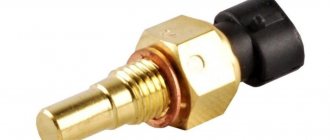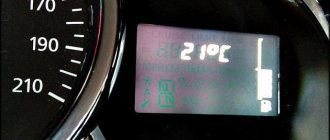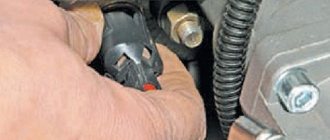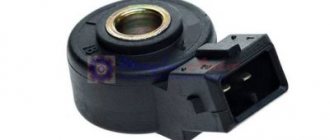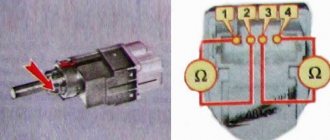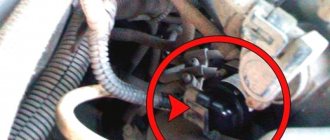The VAZ 2115 line of cars was equipped with injection engines with electronic control units (ECU). The system collects readings from several controllers, and then adjusts the balanced operation of the engine. The coolant temperature sensor on the VAZ 2115 (DTOZH) is one of the main controllers, thanks to which the crankshaft speed, the proportion of the gasoline/air mixture, as well as the ignition are regulated. Next, we will tell you where the t° sensor is located on the 2115 Samara engine, what symptoms indicate its problems, and how to replace the defective device.
Attention! The VAZ 2115 has two types of water t° sensors. The first 1-pin - sends information to the instrument panel. The second 2-pin is responsible for starting/stopping the radiator fan and exchanging readings with the ECU. In this article we will talk about the second type (hereinafter referred to as DTOZH).
Where to find a temperature sensor in a VAZ-2115
The entire cooling system in cars is divided into several types:
- air;
- liquid;
- combined - combining 2 types at once.
The VAZ-2115 has a built-in liquid cooling system, which involves filling with antifreeze or higher quality antifreeze. In general, the mechanism consists of the following functional elements:
- a radiator that allows the engine to cool;
- radiator fan;
- heater radiator;
- cooling device jacket;
- pump pumping coolant;
- expansion tank;
- connecting pipes;
- antifreeze temperature sensor.
Beginners are wondering where the coolant temperature sensor is located on the VAZ-2115? The unit located between the thermostat and the head of the cylinder combination, directly on top of the cooling system pipe, connects the part to the system using 2 wires.
There is another meter installed nearby, but note that this additional unit is connected on one side to the instrument panel.
A careful study of the design allows you to see a resistor in the sensor, where the resistance is determined depending on the heating of the VAZ-2115 engine.
Checking the two-pin sensor
The responsibility assigned to the controller does not allow it to be checked as easily as the previous one. The fact is that the correct operation of the engine directly depends on it. With its help, the optimal quality of the working mixture is selected and the fan is turned on, and this happens at a certain, predetermined temperature. Changing its parameters can lead not only to additional expenses, but also cause, albeit indirectly, the failure of the power unit.
Checking the two-contact engine temperature sensor of the VAZ-2115 is more painstaking and time-consuming. It is done in the following sequence:
- First you need to find the sensor, which is located on the pipe between the cylinder head and the thermostat.
- For greater convenience and safety, it is necessary to dismantle the air filter and remove the terminals from the battery.
- Drain the coolant into a suitable container.
- Disconnect the connector from the sensor.
- Using a 19 mm spanner, unscrew the sensor from its seat.
- Take a liquid thermometer, a multimeter and any device designed to heat water.
- We screw wires of a suitable diameter and length to the sensor contacts. We fix their other ends on the multimeter probes.
- Using the switch, we set the limit on the device to 20 kOhm.
- We lower the sensor into water; the contacts must remain dry. We heat the liquid and monitor the readings of the thermometer and multimeter. They must correspond to those shown in the table.
| Temperature (degrees) | 20 | 40 | 60 | 80 | 100 |
| Resistance (Ohm) | 3520 | 1460 | 667 | 332 | 177 |
When taking measurements, you need to remember that the inertia of the thermometer is less than that of the temperature sensor, therefore, when you reach the next control point, it is better to stop heating for a few seconds and wait for stable multimeter readings. In addition, the temperature values are given with great accuracy, but in reality this will not happen; a spread of 20-30 ohms is quite acceptable.
Temperature meter sensor malfunctions
Knowing the location of the device, it is easy to get rid of the breakdown yourself. The main reasons for the incorrect operation of the device, according to experts, may be:
- lack of contact;
- rupture and wear of insulation, loss of contact integrity;
- the device is completely out of order;
- The fan is not working well.
Signs that should alert the driver of a VAZ-2115 and prompt them to diagnose the condition of the antifreeze temperature sensor may be:
- fan operation when the machine engine is not warmed up;
- the engine is warmed up, but still refuses to function;
- Fuel costs are gradually and steadily increasing.
Signs of failure of the coolant sensor
A number of signs will indicate the need to check the coolant temperature sensor. However, it is worth noting that the situations listed below may be signs of other breakdowns in the car’s engine, therefore, to obtain an accurate result, it is necessary to perform additional diagnostics. So, signs of a faulty coolant temperature sensor include:
- Activation of the warning lamp on the Check Engine panel. However, it can also be activated during other failures, so it is necessary to perform an additional scan of the error code.
- Increased fuel consumption . This is due to the fact that incorrect information is supplied to the electronic control unit, and accordingly, it is also unable to determine exactly how much fuel is needed not only to create an optimal air-fuel mixture, but also to maintain the engine temperature in the normal (non-emergency) range.
- Unstable motor operation . In particular, its unstable operation at idle, difficulty starting (especially in the cold season), spontaneous stopping at low speeds.
- The engine stalls when hot . That is, it may suddenly stall when the critical coolant temperature is reached. Moreover, this does not depend on what kind of coolant was poured into the system (in particular, factory-made antifreeze or ordinary water).
- Problems with the cooling fan on the radiator . This can manifest itself in different ways. In some cases, the fan does not turn on at all, in others it does not turn on in emergency modes, in others it does not turn off even when the engine cools down. When the coolant temperature sensor is disconnected, the electronic control unit perceives this as an open circuit in the sensor and forcibly turns on the fan. In any case, to obtain an accurate picture, it is necessary to perform additional diagnostics of the sensor and/or thermostat.
How to check the temperature sensor for serviceability
DTOZH signals the heating temperature of the antifreeze on the instrument panel of the VAZ-2115.
The condition of the device can be easily checked by following these instructions:
- Start the car and watch the instrument panel readings. When the arrow is fixed at the maximum value and the engine is cold, disconnect the contacts from the temperature measuring device. If the arrow suddenly drops to the possible minimum, then the unit is really out of order and needs to be replaced.
- If the arrow is still at the maximum, consider the contact; perhaps it is shorted to ground on the VAZ-2115.
- If the engine heats up well, but the needle continues to jump or is opposite the zero value, start checking the wear of the fuses.
- If the fuses are not worn out, then it remains to close the contact to ground of the VAZ-2115. Monitor the position of the arrow; if it shoots up, it means the VAZ-2115 DTOZH is not functioning correctly.
How else to check the DTOZH:
- You will need a multimeter, it should be set to ohmmeter mode. Also equip yourself with a thermometer that can measure temperatures greater than 100 degrees. Prepare a container that will not melt under the influence of hot coolant.
- Fix the multimeter probes to the body base and the terminal of the measuring device.
- Place the attached sensor directly into a container with antifreeze and heat it well.
- Look at the thermometer and ohmmeter readings. At a temperature of 30 degrees, the resistance should be equal to 1350-1880 Ohms. If the temperature rises to 50 degrees, the resistance decreases to 585-820 degrees. A temperature of 70 degrees corresponds to a resistance from 280 to 390 Ohms inclusive. If the antifreeze is heated to 90 degrees, the normal resistance value is in the range of 155-196 Ohms. At 110 degrees the resistance is the lowest - from 87 to 109 Ohms.
Features of the VAZ-2115 thermostat and its operating principle
The thermostat is an essential element in a vehicle's cooling system. A new domestically produced part can withstand from 80,000 kilometers to 100,000 kilometers, and an imported one - about 120,000 kilometers. It is very important that the thermostat is of high quality, so it is necessary to purchase it for replacement in specialized auto stores.
A car thermostat controls the temperature of the coolant (for example, antifreeze), and distributes it among circulation circles - small and large. If the vehicle engine and cooling fluid are cold, the thermostat valve will be closed, allowing the small circulation circle to operate.
As soon as the optimal temperature regime of the cooling liquid is reached, the thermostatic valve will operate, that is, it will open and a large circulation circle will come into effect.
The flow of coolant will enter the radiator, and the temperature will stop increasing, and its level will stabilize - optimally 90 degrees. This is the principle of operation of the thermostat element in good condition.
How to change the temperature sensor on a VAZ-2115
The instructions for replacing the VAZ-2115 DTOZH are clear even to a beginner:
- Dismantle the old model, first draining the antifreeze from the car.
- Using the key number 21, place the new unit in the right place.
- Apply heat sealant while tightening the threads.
- Fill in new antifreeze; before using this special product, it is advisable to clean the entire cooling system.
Why the new unit may not work:
- You may have bought a defective device, which is why experts recommend checking the serviceability of the product with a multimeter.
- If there was an antifreeze leak, there is a possibility of the generator getting dirty.
- Screw the sensor tighter.
Step-by-step video instructions for replacing the coolant temperature sensor can be viewed below:
How to make sure the sensor is working properly
First of all, let's consider the option when the temperature indicator on the instrument cluster does not work. Let us remember that a single-contact sensor screwed into the cylinder head is responsible for this. The verification procedure is as follows:
- Invite an assistant. No skill is required from him; his only task is to look at the instrument cluster.
- Open the hood of the car and, observing all safety requirements, make sure that the connector that should be placed on the sensor contact is in place.
- If everything is fine, ask the assistant to turn on the ignition.
- We remove the connector from the contact and short-circuit it to ground.
- If at this time the instrument needle moves to the right, it means that the coolant temperature sensor in the VAZ-2115 is definitely faulty.
- If there is no reaction from the pointer device, the sensor is working. In this case, you should test the instrument cluster and check the wiring.
If a sensor malfunction is diagnosed, it can only be eliminated by replacing it with a new one; the DTOZH cannot be repaired.
Temperature sensor for VAZ 2115
The VAZ 2115 line of cars was equipped with injection engines with electronic control units (ECU). The system collects readings from several controllers, and then adjusts the balanced operation of the engine. The coolant temperature sensor on the VAZ 2115 (DTOZH) is one of the main controllers, thanks to which the crankshaft speed, the proportion of the gasoline/air mixture, as well as the ignition are regulated. Next, we will tell you where the t° sensor is located on the 2115 Samara engine, what symptoms indicate its problems, and how to replace the defective device.
Attention ! The VAZ 2115 has two types of water t° sensors. The first 1-pin - sends information to the instrument panel. The second 2-pin is responsible for starting/stopping the radiator fan and exchanging readings with the ECU. In this article we will talk about the second type (hereinafter referred to as DTOZH).
How to replace the coolant sensor
Coolant temperature sensor VAZ 2109 – VAZ 2115
When driving a car, it is very important for the driver to obtain reliable information from control sensors. But much more important is their uninterrupted operation.
If you notice that the readings of any sensor do not correspond to the actual process, you need to check its condition and, if necessary, replace it.
We propose to consider this problem using an example such as replacing a coolant sensor on a VAZ 2114. First of all, you need to learn to distinguish the coolant temperature sensor from the pointer sensor.
The sensor is an indicator located on the control panel and visually shows the driver the necessary data on the coolant temperature. Temperature detection sensor - installed on the inlet cooling pipe of the cylinder block. See photo below:
VAZ 2114 fluid sensor replacement
The need to monitor the engine cooling system
Every experienced motorist knows perfectly well that overheating a car engine has very dire consequences for the car.
It is the coolant temperature sensor that allows you to monitor the temperature of the engine and, if necessary, take timely measures to correct it.
A reduced temperature does not allow the engine to develop the required power and significantly affects fuel consumption, and an increased temperature can lead to engine seizure. The operation of the coolant temperature sensor is directly connected to the electronic control unit.
Through this block, signals are transmitted from the sensor to other engine components. The timely switching on and off of these jointly working units depends on how accurately this sensor works. In this case, we mean the operation of a fan that cools the engine radiator.
Attention: Some car owners force the above-mentioned fan to turn on. In this case, technical changes are made in the electrical circuit of the car. It is strongly recommended that such issues be resolved in the presence of a specialist - an auto electrician and accompanied by the necessary documentation.
Checking the correct operation of the sensor
It is quite possible to check the accuracy of the sensor readings using an ohmmeter and a small container of coolant. As a visual aid, we suggest watching the video:
In this case, everyone is interested in one question: “How to correct the operation of the sensor?”:
- You can install an on-board computer and set the necessary temperature parameters for the sensor in the program.
- You can include additional resistance in the electrical circuit of the sensor and thereby facilitate the transmission of a signal to turn on the fan at a lower temperature.
It is strongly recommended: All technical problems of this kind must be solved only with the help of a specialist.
Many car enthusiasts are inclined to discuss any engineering solutions, despite the quality of spare parts and the complexity of the vehicle’s operating conditions.
It is for them that we offer an alternative solution to this problem - replacement. Moreover, the price of the issue is not a large expense, and the sensor itself cannot be repaired.
This work can be done with your own hands, without resorting to the services of a service station.
Before replacement, it is strongly recommended to check the condition of the fuses and, if necessary, replace them (see How to replace fuses). They may well affect the operation of the sensor.
Caution: Perform all work on a cold engine, after it has completely cooled down.
Replacement is carried out in the following order:
- Disconnect the negative terminal of the battery.
- Then, the coolant must be drained into a pre-prepared container.
- Disconnect the electrical wiring from the sensor.
- Using the R19 key, unscrew the sensor and remove it together with the sealing ring.
- Next, using a rag, clean the sensor seat.
- We install a new sensor.
- We connect the electrical wiring to the sensor.
- Fill with coolant.
- Connect the negative terminal to the battery.
Therefore, the replacement of this device will be considered completed. This instruction is quite suitable for replacing the coolant temperature sensor on a VAZ 2109 and a VAZ 2115. When installing a new sensor, it is not recommended to use any sealants. This may affect the operation of the sensor itself. The same design solutions are provided for the engine of the VAZ 2112 car.
The only difference is that the thermostat has an increased resistance of the throttle opening. After completing all the work, it is recommended to start the engine, add coolant to the required level and finally check the operation of the sensor.
Principle of operation
The two-contact temperature sensor on the VAZ 2110–2115 family is a resistor mechanism with a negative temperature coefficient. That is, in the cold its resistance is high, and when heated, on the contrary, it is low. During operation, the DTOZ transmits impulses to the ECU. The device has 2 contacts: one for communication with the control unit, the second for starting/stopping the radiator fan.
Table 1. Units of measurement of water temperature and data on DTOZH VAZ 2115
| Degrees t°C | Resistance (Ohm) |
| 100 | 177 |
| 40 | 1459 |
| 0 | 9420 |
| −20 | 28680 |
| −40 | 100700 |
Information for self-checking with the meter
Simply put, the VAZ 2115 temperature sensor (8-valve injector) performs one of the functions of a damper (choke), which was traditionally located on carburetor cars. Having received readings from the DTOZH, the ECU system ensures that the cold engine is injected with a rich fuel mixture, and the hot engine is injected with a lean mixture.
Operating principle and functions of the device
The design and operating principle of the temperature meter have changed little since its first use on a car. Due to modern materials used in the manufacture of the sensor, it has decreased in size, and the accuracy of the readings has increased. The device is a thermal variable resistor enclosed inside a metal case with a threaded tip . When heated, the thermoelement reduces the resistance of the electrical circuit, which allows the electronic control unit (otherwise known as the controller, ECU) to determine the temperature of the coolant.
The following functions depend on the operation of the temperature sensor:
- Traditionally, the coolant temperature indicator operates from meter signals.
- Timely activation of forced engine cooling fans when the antifreeze reaches the set temperature threshold (about 100 °C).
- Enriching the air-fuel mixture and increasing idle speed on a cold engine.
- While driving, the controller collects readings from all sensors and, on this basis, forms the ratio of fuel and air in the mixture. The temperature meter is also involved in this process.
The design of a modern car may provide for the installation of several heating meters responsible for certain functions. Their location varies:
- on the upper pipe leading from the cylinder block to the radiator;
- in the thermostat housing;
- in the cylinder head;
- directly into the radiator.
It is not difficult to distinguish thermocouples from other types of sensors . All devices built into the engine cooling system and connected by wires to the controller are designed for temperature measurements. The only point: when you start looking for the location of the temperature meter for the purpose of checking, do not confuse the device with the knock sensor built directly into the cylinder block. When a machine has several thermal elements, their functions are usually distributed as follows:
- a meter built into the pipe is involved in preparing the fuel mixture for the engine;
- a device located in the radiator ensures that a cooling fan (or two) is turned on;
- The sensor in the cylinder head is responsible for the coolant temperature gauge.
Most low- and mid-price cars use one temperature sensor that performs all functions simultaneously. Usually it is located on the thermostat housing or on the upper radiator pipe .
Causes and symptoms of malfunction
In most cases, if the temperature sensor stops working on a VAZ 2115, then most often the problems occur for natural reasons (for example, rupture of internal contacts). A faulty device sends incorrect engine temperature information to the control unit. And the computer reads the starting temperature of the engine as 0 °C, after which it orders another sensor, the mass air flow sensor, to add air, that is, to enrich the mixture. Sometimes problems arise because:
- the seal of the housing is broken;
- broken electrical wiring;
- The connector fell off the block.
As a result, the yellow “Check Engine” icon lights up on the panel. Thus, the ECU warns the driver about problems in the system. What symptoms on a working VAZ 2115 indicate that the temperature sensor “died a heroic death”:
- difficult starting, especially in frosty weather;
- floating speed until fully warmed up t 90 °C;
- strong detonation appears;
- power is lost;
- the engine stalls.
In addition to the listed defects, gasoline consumption increases noticeably, and dark smoke comes out of the exhaust pipe.
Which thermostat to choose
Motorists have no consensus on which thermostat is better. But the experience of using different devices allows us to draw several conclusions:
- High-quality domestic models of thermostats for the VAZ-2115 are capable of operating for 80-100 thousand kilometers.
- Foreign brands guarantee operation until the car travels 120,000 km or more.
- It is not recommended to purchase Chinese-made equipment.
The following models of thermostats for the VAZ-2115 are available on the domestic market, which are sold at the prices shown below:
- Russian PEKAR, costing 530 rubles;
- French VERNET, for 670 rubles;
- American GATES, priced at 525 rubles;
- domestic ELECTON - 515 rubles;
- Lugansk LUZAR - 1,000 rubles;
- VAZ AvtoVAZ - 850 rubles.
This list is not exhaustive. There are a number of other models that have proven themselves quite well. You need to decide where to choose and install the thermostat on the VAZ-2115 based on your available finances, reviews from friends and the opinions of professionals who are generously represented on the Internet.
Where is the temperature sensor located?
The front-wheel drive family from Togliatti has a transverse engine installation. The VAZ 2115 temperature sensor is located between the cylinder block and the thermostat. It is located on the coolant flange located on the right side of the engine. The sensor is easy to see if you look down, between the head and the air filter housing. (A little lower, directly into the block, a 1-pin water t° indicator sensor is screwed in. 1 green wire goes to it).
Mass air flow sensor
Mass air flow sensor is one of the most expensive sensors in a car. It is responsible for counting the air passing through it. These readings are necessary for proper mixing of air and fuel. The flow meter can fail if the air filter is not replaced for a long time, as well as with strong ventilation of crankcase gases due to the high content of oil combustion products in the internal combustion engine. It is located on the air filter housing and is attached to it with two bolts.
Signs of malfunction:
- Uneven idle speed;
- Increased fuel consumption;
- Long start of the internal combustion engine;
Replacement
To install a new cooling sensor on the LADA 2115 Samara, you need to select a flat area. You will need a tool: open-end and spanner wrenches (19 mm, 13 mm, 10 mm, 8 mm), as well as a large medical syringe 100–250 ml, and a 15–20 cm dropper tube to it. It is recommended to buy the original sensor itself, here its number is 21120–3851010–05. It is easy to replace the DTOZH yourself. The step-by-step process looks like this:
- Allow the engine to cool to at least 40 °C.
- Use a syringe to pump out antifreeze/antifreeze from the expansion tank (so as not to drain the coolant).
- Unscrew the negative terminal of the battery (10–13 mm wrench).
- Disconnect the plug from the air flow sensor.
- Unscrew the air filter housing (8 mm wrench).
- Carefully removes the “pan” and moves it to the right.
- Disconnect the plug from the DTOZH.
- Unscrew the sensor (19 mm spanner).
- Cleaning the landing area.
- We screw in the new DTOZH.
Let's collect everything in reverse chronology. It is not recommended to use sealant, as the copper ring is perfectly crimped, ensuring a tight seal.
The principle of operation and design of the thermostat
The car's thermostat helps regulate the temperature of the coolant in the cooling system. While the coolant (water or antifreeze) is at a low temperature, for example, during engine startup, it circulates through a small circle of the cooling system, bypassing the radiator.
When the liquid temperature rises to 90–95°C, the device opens the thermostat valve, causing water or antifreeze to flow through a large circulation circle. Now the radiator and the fan blowing air onto it are included in the cooling process.
When the temperature drops, the reverse process occurs: the valve closes the large circulation circle. And the temperature of the liquid rises to optimal values.
The main part of the device is a cylinder containing crystalline wax (ceresin). The melting point of this material is 65–88°C. When it reaches it, the wax begins to expand and press on the spring-loaded valve plates through the stem. This opens the valve, allowing fluid to flow to the radiator. As the wax cools, it hardens and contracts, and the plates snap into place.
Summary
The coolant temperature sensor is an important element for the balanced operation of the VAZ 2115 engine. If it malfunctions, the car loses its driving characteristics: it starts poorly, stalls, loses power, consumes more fuel, and sometimes the engine does not work at all. You can replace the DTOZH yourself using a minimal set of tools.
TOZh sensors, from left to right: 1 Sensor for the fan, 2 sensor for the pointer, 3 a cleverly crafted old sensor of mine.
The conclusion is this: there are two temperature sensors - one for the “brains”, the fan, the on-board computer. (It screws in vertically, is easy to change, costs a little more. - the second one is on the arrow (single-pin, screwed horizontally under the pipe), behaves strangely when screwed in.
Now I will look for and ask for a sensor like my old one (in the photo with an orange neck). He gave me temperature readings exactly the same as on BC.
Sensor layout
The sensors under the hood of the VAZ 2115 are located as follows.
1. Phase sensor; 2. Coolant temperature sensor; 3. Knock sensor; 4. Oil pressure sensor; 5. Oxygen sensor; 6. Crankshaft position sensor; 7. Speed sensor; 8. Idle speed sensor; 9. Mass air flow sensor; 10-11. Gasoline level sensor; 12. Antifreeze level sensor; 13. Throttle position sensor
Features of the DTOZH operation on the fifteenth VAZ model
The coolant temperature sensor (CTS) relates to the cooling system of the machine. Its purpose is to control the coolant temperature. While the engine is cold, the ECU sets an enriched fuel assembly; after the engine warms up, it becomes normal.
The device is a resistor called a thermistor placed in a metal case.
Device diagram
The resistance of the thermistor increases as the temperature decreases, and at the same time the voltage supplied to it will increase.
What symptoms indicate problems with the sensor?
During long-term operation of the car, obvious and indirect signs may be observed indicating problems with the temperature sensor or its electrical circuit. The first ones directly indicate the need to check the functionality of the device:
- The engine heating indicator on the dashboard stopped working;
- the cooling fan stopped turning on, although the engine water jacket had already warmed up to 100 °C;
- antifreeze leakage from under the part body;
- The fan starts at random, including when the engine is cold.
If your car exhibits the listed signs of a malfunction of the coolant temperature sensor, then feel free to proceed to diagnosing it and fixing the problem, which will be discussed below. Indirect symptoms may indicate a breakdown of the meter or other elements of the cooling system or power unit. Here are the most common ones:
- Cold starting of the engine is difficult. The car starts, but immediately stalls, you need to make several repeated attempts. The cause may be a thermocouple, throttle position sensor, insufficient compression or ignition problems.
- Unstable operation at idle. In addition to the temperature meter, it is affected by the serviceability of the spark plugs, mass flow sensor, injectors and many other factors.
- The temperature is within normal limits, but the coolant begins to boil. If the thermostat fails or the level of antifreeze in the jacket decreases, then the readings of the device may differ from the real state of affairs.
The serviceability of an electronic temperature meter can be checked at home. If indirect symptoms of a malfunction are observed, the test will help to identify them or exclude them from a number of parts that are “under suspicion.” If you successfully check the problem, you will have to look elsewhere or contact the nearest auto repair shop.
Possible sensor malfunctions
If the DTOZH breaks down, the ECU considers that the engine temperature is zero, so it enriches the combustible mixture. A broken device must be replaced as quickly as possible. Most often, a meter malfunction is a calibration violation. In this case, the resistance does not change correctly, and since the control unit is based on meter readings, it does not work correctly.
You can identify a DTOZ malfunction by turning on the fan. It should turn on if permissible values are exceeded. True, there is also a fan switch sensor, which can also fail.
Thus, the fan may not turn on if:
- contacts have oxidized;
- wiring is damaged;
- sensors are faulty.
Incorrect operation of the DTOZ leads to increased fuel consumption, detonation, and high idle speeds. The most dangerous thing is if the engine temperature sensor is broken. In this case, the fan does not start, there is no cooling of the engine, it overheats, and as a result, the cylinder head may misfire.
Sensors, their purposes and malfunctions
Let's now talk in more detail about each of the sensors, let's look at where they are and what they look like.
Idle speed (IAC)
The device is located in the throttle assembly. It is a small induction coil with a needle inside. Depending on the controller readings, one or another voltage is applied to the coil winding and the needle extends a certain distance into the throttle pipe, regulating the air supply. With this, the idle speed is adjusted.
There is no indicator responsible for this sensor. Therefore, if this node fails, then this can be understood by the following “symptoms”:
- The engine stalls at idle or when changing speed;
- “Floating”, unstable idle speed;
- When turning on a cold engine, there is no increased speed.
Methods for checking the regulator for operability
Before checking the meter, you should first check the serviceability of the fuses, the integrity of the wiring and measure the incoming voltage, which should be 5V. If there are no wiring faults and the voltage is normal, then the meter is checked for resistance. To check it, you need to remove it (the author of the video is Car Design and Repair).
To check, you will need an electric kettle, a thermometer to measure the outside temperature, and a multimeter set to resistance measurement mode.
It is advisable to take an electronic thermometer not to measure the outside air temperature.
There are two ways to check:
- In the first case, the coolant temperature sensor with a thermometer is placed in an electric kettle. In this case, the device must be connected to the tester. The electric kettle should be plugged in and monitor the readings. As the temperature increases, the resistance should increase. When it becomes +15 degrees, the resistance should be 4450 Ohms, +40 - 1459 Ohms. At 100 degrees, the resistance reaches a minimum of 177 Ohms. If the values are different, this indicates a malfunction.
- If there is no thermometer, then the meter is checked after the water boils. When immersed in freshly boiled water, the multimeter should display a resistance of slightly more than 177 ohms. Otherwise the device is broken.
Checking with a multimeter
Why the VAZ 2114 cooling fan does not work
The fan electric motor starts working only after the antifreeze temperature in the radiator reaches 100 degrees. To do this, it is connected to the on-board network via a thermal relay. If the coolant temperature is more than 90 degrees, and the fan does not turn on, then the reasons may be as follows:
- faulty fan fuse;
- break or poor contact in the fan motor power supply circuit;
- breakdown of the temperature sensor (cooling fan relay) VAZ 2114;
- poor contact on the temperature sensor connector;
- the fan itself is malfunctioning.
Before starting repairs, it is necessary to find out the cause of the malfunction.
How to find out the cause of the problem
You should start by checking fuse F4 (20A)kre, located on the left under the hood in the mounting block. This fuse also protects the horn power circuit. So, to check it, you can simply press the signal button. If it works, then the fuse is fixed. If not, then the latter should be replaced with a working one.
You can then continue by checking the fan motor itself. To do this, you need to unplug its connector and power the electric motor from the battery directly with wires. If the impeller starts to rotate, then the fan is working. Does the VAZ 2114 cooling fan not work? We continue to search for the cause. The next step is to check the condition of the fan sensor contacts and the integrity of the wires going both to the fan itself and to the sensor (VAZ 2114 cooling fan relay). The sensor is installed so that if it is de-energized, the control unit will start the electric cooling fan in forced operation mode. It's easy to check - just unplug its power connector and turn on the ignition. If the fan starts working, then the relay (sensor) needs to be replaced.
When should you change a cooling fan?
If the VAZ 2114 cooling fan does not turn on, it is not at all necessary to change the entire unit. You can try to repair it by replacing the brushes or bearings. If the cause of its breakdown is a short circuit or break in the winding of the electric motor, it will not be possible to repair the electric motor. In this case, you will have to replace it with a new one.
Checking the Thermostat
The functionality of the VAZ-2115 thermostat is checked if it is suspected of malfunctioning. This may be indicated by:
- slow engine warm-up;
- continued heating of the coolant after reaching 95 °C;
- a sharp drop in temperature when the engine switches from idle to operating speed.
There are three ways to check the VAZ-2115 thermostat. You can do everything yourself, without contacting the service.
Method 1
To check the serviceability in this way you need to:
- Start the engine.
- Let it run for about 10 minutes until it warms up completely.
- Check the temperature of the upper and lower radiator pipes by touch by hand:
- if the thermostat is working properly, both pipes will be hot;
- if the device malfunctions, the pipes going to the radiator will remain cold, since the antifreeze will continue to circulate in a small circle.
This method of testing is simple and effective, but you must be careful not to get burned.
For your information. Sometimes tapping on the body of the thermostatic element helps restore functionality.
Method 2
The check resembles the first option. But in this case, the main attention is paid to the warm-up time of the VAZ-2115 engine. The procedure is as follows:
- Start the car.
- Without waiting for warming up, touch the pipes:
- with a working thermostat, the pipes will remain cold until the engine warms up to 90–95 °C;
- if faulty, the lower and upper pipes will heat up gradually immediately after starting the engine.
Important! When the liquid constantly circulates in a large circle, you can drive without worrying about the consequences. But if the valve is closed and not activated, movement is prohibited, as the engine will overheat. If the situation is hopeless, you can simply remove the part using a screwdriver.
Method 3
This method requires dismantling the temperature support device. Algorithm of actions:
- Prepare the VAZ-2115 car for removing the thermostat: if the car was running, turn off the engine and wait until the engine cools down.
- Remove the thermostat (how to dismantle this equipment will be discussed below).
- Place the device in a container of water and heat until it starts to boil.


